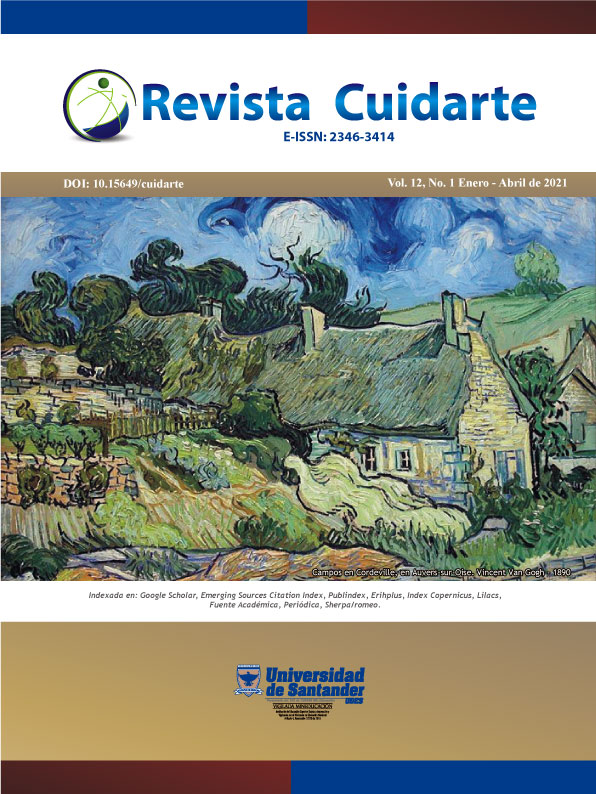Inactivación potencial del coronavirus SARS-CoV2: ¿qué agentes germicidas se proponen?
DOI:
https://doi.org/10.15649/cuidarte.1273Palabras clave:
SARS-CoV2, Antibacterianos, Inactivación de VirusResumen
La enfermedad por coronavirus 2019 (COVID-19), una afección respiratoria aguda causada por el SARS-CoV2, ha sido clasificada como pandemia por la Organización Mundial de la Salud (OMS) una vez que se ha expandido a 215 países del mundo, ha infectado a más de 7.800.000 personas y cerca de 440.000 personas han muerto por su causa1.
El SARS-CoV2 es un coronavirus tipo β de características genómicas similares al MERS-CoV y al SARS-CoV1 los cuales afectaron a más de 10.000 personas en las últimas dos décadas2,3. Debido a la alta tasa de contagio y propagación del SARS-CoV2, diversas medidas de mitigación han sido empleadas. Entre las medidas adoptadas se encuentran la cuarentena, el distanciamiento físico, la limpieza de superficies y aerosoles, así como el uso de equipos de protección personal (EPP)2–6
Dado que no se dispone de vacuna y tratamientos suficientemente efectivos, evitar el contagio por contacto directo con superficies, aerosoles o suspensiones contaminadas con el SARS-CoV2 es la primera y más importante medida de contención contra la pandemia7. Esto obedece a que el SARS-CoV2 puede sobrevivir por 3 h en aerosoles, 4 h en superficies de cobre, un día en cartón, dos días en acero inoxidable y hasta 3 días en plástico8. Dada la alta demanda de los EPP, que provoca escasez y obliga a la reutilización de estos7,9, métodos eficaces de limpieza son cruciales.
Como citar este artículo: Wilches Visbal Jorge Homero, Castillo Pedraza Midian Clara, Serpa Romero Xiomara Zilena. Inactivación potencial del coronavirus SARS-CoV2: ¿qué agentes germicidas se proponen?. Revista Cuidarte. 2021;12(1):e1273. http://dx.doi.org/10.15649/cuidarte.1273
Referencias
Colombia. Ministerio de Salud y Protección Social. Reporte Mundial y Nacional de Casos por COVID-19 [Internet]. 2020 [citado 16 de junio de 2020]. Disponible en: https://twitter.com/MinSaludCol/status/1272648258435891202
Fernandez D, Alonso LM, Fernández JA, Ordás B MS. Todo lo que necesitas saber del Coronavirus. Tiempos enfermería y salud [Internet]. 2019;2(7):1-10. Disponible en: https://tiemposdeenfermeriaysalud.es/journal/article/view/73/60
Fallahi HR, Keyhan SO, Zandian D, Kim S-G, Cheshmi B. Being a front-line dentist during the Covid-19 pandemic: a literature review. Maxillofac Plast Reconstr Surg. 2020;42(1):1-9. https://doi.org/10.1186/s40902-020-00256-5
Güner R, Hasanoğlu İ, Aktaş F. Covid-19: Prevention and control measures in community. Turkish J Med Sci. 2020;50(SI-1):571-7. https://doi.org/10.3906/sag-2004-146
Peng X, Xu X, Li Y, Cheng L, Zhou X, Ren B. Transmission routes of 2019-nCoV and controls in dental practice. Int J Oral Sci [Internet]. 3 de diciembre de 2020;12(1):1-9. https://doi.org/10.1038/s41368-020-0075-9
Balachandar V, Mahalaxmi I, Kaavya J, Vivekanandhan G, Ajithkumar S, Arul N, et al. COVID-19: Emerging protective measures. Eur Rev Med Pharmacol Sci. 2020;24(6):3422-5.
Kampf G, Todt D, Pfaender S, Steinmann E. Persistence of coronaviruses on inanimate surfaces and their inactivation with biocidal agents. J Hosp Infect [Internet]. 2020;104(3):246-51. https://doi.org/10.1016/j.jhin.2020.01.022
Van Doremalen N, Bushmaker T, Morris DH, Holbrook MG, Gamble A, Williamson BN, et al. Aerosol and Surface Stability of SARS-CoV-2 as Compared with SARS-CoV-1 [Internet]. The New England journal of medicine. 2020. p. 1-4. https://doi.org/10.1101/2020.03.09.20033217
Center for Disease Control and Prevention (CDC). Recommended Guidance for Extended Use and Limited Reuse of N95 Filtering Facepiece Respirators in Healthcare Settings [Internet]. 2020 [citado 16 de junio de 2020]. Disponible en: https://www.cdc.gov/niosh/topics/hcwcontrols/recommendedguidanceextuse.html
Kampf G, Voss A, Scheithauer S. Inactivation of coronaviruses by heat. J Hosp Infect [Internet]. Disponible en: https://www.journalofhospitalinfection.com/article/S0195-6701(20)30124-9/fulltext
Welch D, Buonanno M, Grilj V, Shuryak I, Crickmore C, Bigelow AW, et al. Far-UVC light: A new tool to control the spread of airborne-mediated microbial diseases. Sci Rep [Internet]. 2018;8(1):1-7. https://doi.org/10.1038/s41598-018-21058-w
Buonanno M, Welch D, Shuryak I, Brenner DJ. Far-UVC light efficiently and safely inactivates airborne human coronaviruses. Res Sq [Internet]. 2020. https://doi.org/10.21203/rs.3.rs-25728/v1
Theory Division CCLRI, Card KJ, Crozier D, Dhawan A, Dinh M, Dolson E, et al. UV Sterilization of Personal Protective Equipment with Idle Laboratory Biosafety Cabinets During the Covid-19 Pandemic. medRxiv [Internet]. 2020;2020.03.25.20043489. Disponible en: https://www.medrxiv.org/content/10.1101/2020.03.25.20043489v1%0Ainternal-pdf://0.0.23.4/2020.03.25.html
Center for Disease Control and Prevention (CDC). Use of Cloth Face Coverings to Help Slow the Spread of COVID-19 [Internet]. 2020 [citado 16 de junio de 2020]. Disponible en: https://espanol.cdc.gov/coronavirus/2019-ncov/prevent-getting-sick/cloth-face-cover.html?fbclid=IwAR0yZorXdc1BAEcG9kPErLFzTvr1_CAtdwcdajQ5STizoz9r8qT1wqorG3E
U.S. Food and Drug Administration (FDA). Surgical Mask and Gown Conservation Strategies - Letter to Health Care Providers [Internet]. 2020 [citado 16 de junio de 2020]. Disponible en: https://www.fda.gov/medical-devices/letters-health-care-providers/surgical-mask-and-gown-conservation-strategies-letter-health-care-providers
International Atomic Energy Agency (IAEA). Radiation Effective in Sterilizing Personal Protective Equipment Except For Respiratory Masks [Internet]. 2020 [citado 17 de mayo de 2020]. Disponible en: https://www.iaea.org/newscenter/pressreleases/radiation-effective-in-sterilizing-personal-protective-equipment-except-for-respiratory-masks-iaea
Pastorino B, Touret F, Gilles M, Lamballerie X De, Charrel RN. Evaluation of heating and chemical protocols for inactivating SARS-CoV-2. bioRxiv [Internet]. 2020;0-8. https://doi.org/10.1101/2020.04.11.036855
Publicado
Cómo citar
Altmetrics
Descargas
Licencia
Journal Cuidarte, scientific publication of open access, is licensed under a Creative Commons Attribution (CC BY-NC), which permits use, distribution and reproduction in any medium, provided the original work is properly cited and is not used for commercial purposes.
Any other form of use such as reproduction, transformation, public communication or distribution, for profit, requires the prior authorization of the University of Santander UDES.
The names and e-mail addresses entered in the Journal Cuidarte will be used exclusively for the purposes stated by this magazine and will not be available for any other purpose or other person.
The articles published in the Journal Cuidarte represent the criteria of their authors and do not necessarily constitute the official opinion of the University of Santander UDES.







